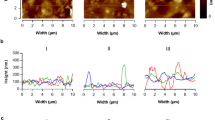The adhesion of a hydrophilic Escherichia coli and a hydrophobic Staphylococcus epidermidis was significantly higher to silicone-coated latex than to a hydrophilic lubricious-coated catheter after 24 h incubation. Time-course studies showed a steady increase in viable E. coli adhesion to the hydrophilic catheter over 24 h. However, in contrast to thermodynamic modelling predictions, S. epidermidis adhered well to the hydrophilic catheter within 30–60 min. By 18 h the adherent S. epidermidis were non-viable, apparently demonstrating the presence of an unidentified antibacterial factor on this catheter. A range of creatinine concentrations had some effect on the adhesion. Bacterial binding was significantly higher in low urea concentrations (<200 mm) and was significantly affected by variation of pH from 3 to 9. There was some correlation between the suspending fluid surface tension, ΔF Adh, and the experimental adhesion.
Similar content being viewed by others
References
M. TREXLER HESSEN and D. KAYE, in “Infections Associated with Indwelling Medical Devices”, edited by A. L. Bisno and F. A. Waldvogel (American Society for Microbiology, Washington, DC, 1989) p. 199.
H. J. BUSSCHER, J. SJOLLEMA and H. C.VAN DER MEI, in “Microbial Cell Surface Hydrophobicity”, edited by R. J. Doyle and M. Rosenberg, (American Society for Microbiology, Washington, DC, 1990) p. 335.
J. W. COSTERTON, T. J. MARRIE and K.-J. CHENG, in “Bacterial Adhesion: Mechanisms and Physiological Significance”, edited by D. C. Savage and M. Fletcher (Plenum Press, New York, 1985) p. 3.
A. G. GRISTINA, Science 237 (1987) 1588.
C. D. GIVENS and R. P. WENZEL, J. Urol. 124 (1980) 646.
E. J. YOUNG and B. SUGARMAN, in “Infections Associated with Prosthetic Devices”, edited by B. Sugarman and E. J. Young (CRC Press, Boca Raton, Florida, 1984) p. 2.
C. M. KUNIN and C. STEELE, J. Clin. Microbiol. 21 (1985) 902.
L. A. HAWTHORN and G. REID, J. Biomed. Mater. Res. 24 (1990) 1325.
L. A. HAWTHORN and G. REID, J. Biomed. Mater. Res. 24 (1990) 39.
G. REID, H. S. BEG, C. A. K. PRESTON and L. A. HAWTHORN, Biofouling 4 (1991) 171.
G. REID, L. A. HAWTHORN, A. EISEN and H. S. BEG, Colloids Surf. 42 (1989) 299.
N. TIETZ, “Clinical Guide to Laboratory Tests” (W. B. Saunders, Philadelphia, 1990).
G. REID, PhD thesis, Massey University, New Zealand (1982).
J. F. BOYCE, S. SCHURCH, Y. ROTENBERG and A. W. NEUMANN, Colloids Surf. 9 (1984) 307.
W. C. DUNCAN-HEWITT, Z. POLICOVA, P. CHENG, E. I. VARGHA BUTLER and A. W. NEUMANN, Colloids Surf. 42 (1989) 391.
F. W. SKINNER, Y. ROTENBERG and A. W. NEUMANN, J. Colloid Interf. Sci. 130 (1989) 25.
A. W. NEUMANN and R. J. GOOD, in “Surface and Colloid Science II: Experimental Methods”, edited by R. J. Good and R. R. Stromberg (Plenum Press, New York, 1979) p.31.
A. W. NEUMANN, R. J. GOOD, C. J. HOPE and M. SEJPAL, J. Colloid Interf. Sci. 49 (1974) 291.
D. LI and A. W. NEUMANN, J. Colloid Interf. Sci. 137 (1990) 304.
P. CHENG, D. LI, L. BORUVKA, Y. ROTENBERG and A. W. NEUMANN, Colloids Surf. 43 (1990) 151.
Y. ROTENBERG, L. BORUVKA and A. W. NEUMANN, J. Colloid Interf. Sci. 93 (1983) 169.
R. C. Y. CHAN, A. W. BRUCE and G. REID, J. Urol. 131 (1984) 596.
B. J. WINER, in “Statistical Principles in Experimental Design”, 2nd Edn (McGraw-Hill, Toronto, 1971) p. 514.
J. A. ROBERTS, E. N. FUSSELL and M. B. KAACK, J. Urol. 144 (1990) 264.
R. V. LACHICA, in “Microbial Cell Surface Hydrophobicity”, edited by R. J. Doyle and M. Rosenberg (American Society for Microbiology, Washington, DC, 1990) p. 297.
T. WADSTROM, S. HJERTEN, P. JOHSSON and S. TYLEWSKA, Zentralbl. Bacteriol. 10A (Suppl.) (1981) 441.
J. A. D. ANDRADE, Med. Instrum. 7 (1973) 110.
S. C. DEXTER, J. D. SULLIVANJr, J. WILLIAMS and S. W. WATSON, Appl. Microbiol. 30 (1975) 298.
Author information
Authors and Affiliations
Rights and permissions
About this article
Cite this article
Reid, G., Lam, D., Policova, Z. et al. Adhesion of two uropathogens to silicone and lubricious catheters: influence of pH, urea and creatinine. J Mater Sci: Mater Med 4, 17–22 (1993). https://doi.org/10.1007/BF00122972
Received:
Accepted:
Issue Date:
DOI: https://doi.org/10.1007/BF00122972




